change wheel FIAT BARCHETTA 2003 1.G Owners Manual
[x] Cancel search | Manufacturer: FIAT, Model Year: 2003, Model line: BARCHETTA, Model: FIAT BARCHETTA 2003 1.GPages: 170, PDF Size: 3.55 MB
Page 72 of 170

71
GEAR USE
To engage the gears, press down
the clutch and put the gear lever into
one of the positions shown in the
diagram infig. 2(the diagram is also
on the gear lever knob).
IMPORTANT The car can be put
in reverse only when it has com-
pletely stopped moving. With engine
running, before engaging the reverse,
wait at least 2 seconds with clutch
pedal completely pressed down to
prevent damage and grating of gears.
Do not drive with your
hand resting on the gear
stick as the force exerted,
even if only slight, could lead to
premature wearing of the gear-
box internal components.
fig. 2
P5S00679m
SAFE DRIVING
In designing the Fiat barchetta, Fiat
has made every effort to come up with
a car able to provide driver and pas-
senger with top-class levels of safety.
Nevertheless it is always the behaviour
of the person at the wheel that de-
termines road safety.
Below you will find some simple tips
to help you travel in safety under dif-
ferent conditions. You will no doubt
be familiar with many of them already
but it will be useful to read them all
carefully.
You must push the clutch
pedal fully down to change
gear properly. It is therefore essen-
tial that there is nothing under the
pedals: make sure mats are lying
flat and do not get in the way.
WARNING
Page 74 of 170
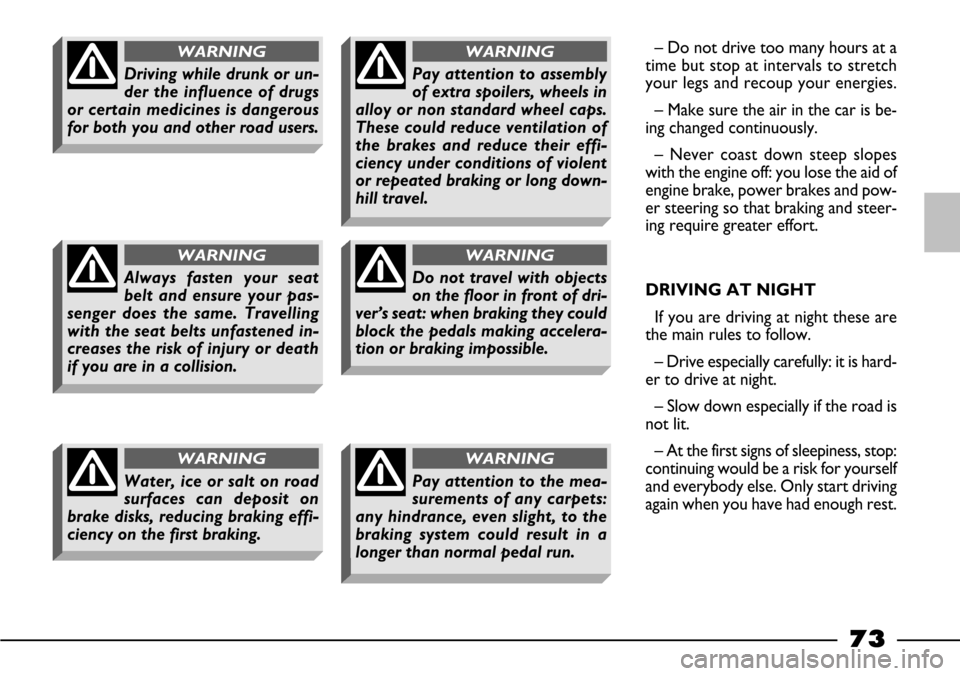
73
– Do not drive too many hours at a
time but stop at intervals to stretch
your legs and recoup your energies.
– Make sure the air in the car is be-
ing changed continuously.
– Never coast down steep slopes
with the engine off: you lose the aid of
engine brake, power brakes and pow-
er steering so that braking and steer-
ing require greater effort.
DRIVING AT NIGHT
If you are driving at night these are
the main rules to follow.
– Drive especially carefully: it is hard-
er to drive at night.
– Slow down especially if the road is
not lit.
– At the first signs of sleepiness, stop:
continuing would be a risk for yourself
and everybody else. Only start driving
again when you have had enough rest.
Driving while drunk or un-
der the influence of drugs
or certain medicines is dangerous
for both you and other road users.
WARNING
Always fasten your seat
belt and ensure your pas-
senger does the same. Travelling
with the seat belts unfastened in-
creases the risk of injury or death
if you are in a collision.
WARNING
Water, ice or salt on road
surfaces can deposit on
brake disks, reducing braking effi-
ciency on the first braking.
WARNING
Pay attention to assembly
of extra spoilers, wheels in
alloy or non standard wheel caps.
These could reduce ventilation of
the brakes and reduce their effi-
ciency under conditions of violent
or repeated braking or long down-
hill travel.
WARNING
Do not travel with objects
on the floor in front of dri-
ver’s seat: when braking they could
block the pedals making accelera-
tion or braking impossible.
WARNING
Pay attention to the mea-
surements of any carpets:
any hindrance, even slight, to the
braking system could result in a
longer than normal pedal run.
WARNING
Page 81 of 170
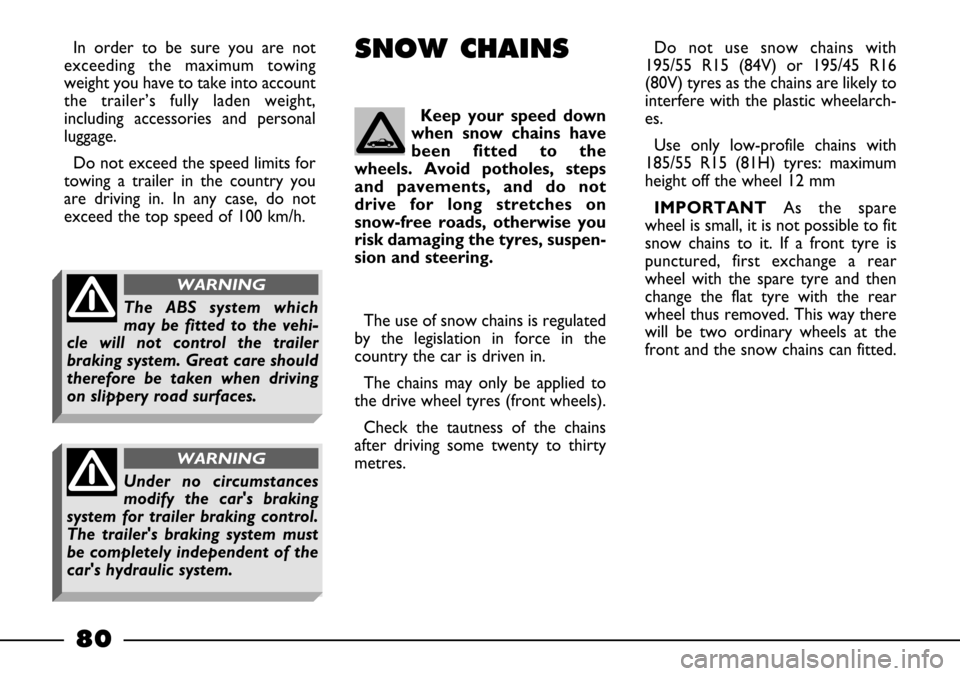
80
In order to be sure you are not
exceeding the maximum towing
weight you have to take into account
the trailer’s fully laden weight,
including accessories and personal
luggage.
Do not exceed the speed limits for
towing a trailer in the country you
are driving in. In any case, do not
exceed the top speed of 100 km/h. SNOW CHAINS
Keep your speed down
when snow chains have
been fitted to the
wheels. Avoid potholes, steps
and pavements, and do not
drive for long stretches on
snow-free roads, otherwise you
risk damaging the tyres, suspen-
sion and steering.
The use of snow chains is regulated
by the legislation in force in the
country the car is driven in.
The chains may only be applied to
the drive wheel tyres (front wheels).
Check the tautness of the chains
after driving some twenty to thirty
metres.Do not use snow chains with
195/55 R15 (84V) or 195/45 R16
(80V) tyres as the chains are likely to
interfere with the plastic wheelarch-
es.
Use only low-profile chains with
185/55 R15 (81H) tyres: maximum
height off the wheel 12 mm
IMPORTANT As the spare
wheel is small, it is not possible to fit
snow chains to it. If a front tyre is
punctured, first exchange a rear
wheel with the spare tyre and then
change the flat tyre with the rear
wheel thus removed. This way there
will be two ordinary wheels at the
front and the snow chains can fitted.
The ABS system which
may be fitted to the vehi-
cle will not control the trailer
braking system. Great care should
therefore be taken when driving
on slippery road surfaces.
WARNING
Under no circumstances
modify the car's braking
system for trailer braking control.
The trailer's braking system must
be completely independent of the
car's hydraulic system.
WARNING
Page 87 of 170
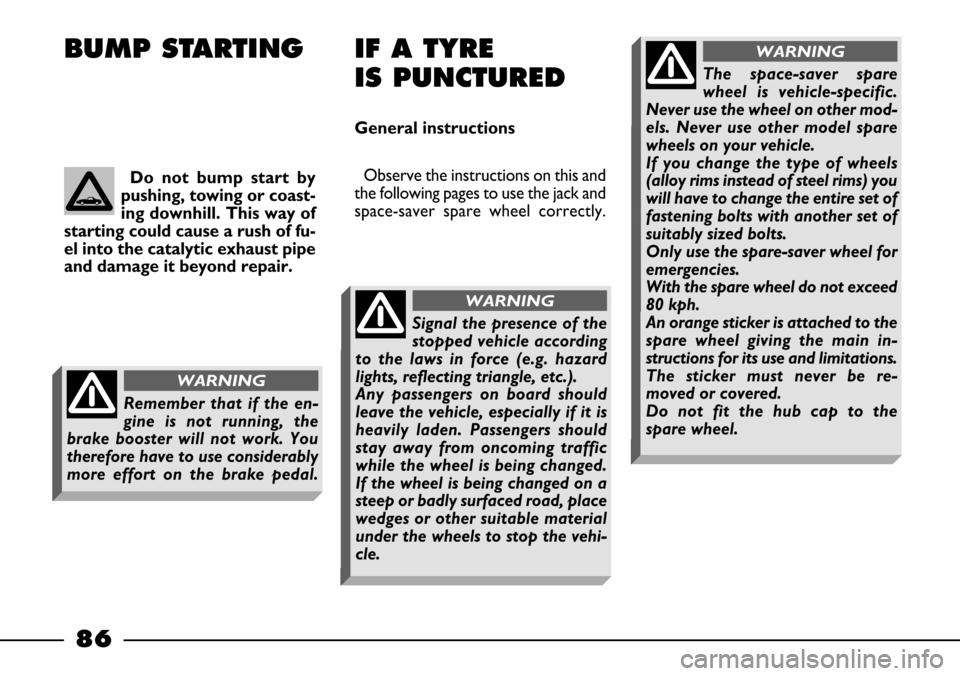
86
Observe the instructions on this and
the following pages to use the jack and
space-saver spare wheel correctly.
BUMP STARTING IF A TYRE
IS PUNCTURED
General instructions
Do not bump start by
pushing, towing or coast-
ing downhill. This way of
starting could cause a rush of fu-
el into the catalytic exhaust pipe
and damage it beyond repair.
Signal the presence of the
stopped vehicle according
to the laws in force (e.g. hazard
lights, reflecting triangle, etc.).
Any passengers on board should
leave the vehicle, especially if it is
heavily laden. Passengers should
stay away from oncoming traffic
while the wheel is being changed.
If the wheel is being changed on a
steep or badly surfaced road, place
wedges or other suitable material
under the wheels to stop the vehi-
cle.
WARNING
Remember that if the en-
gine is not running, the
brake booster will not work. You
therefore have to use considerably
more effort on the brake pedal.
WARNING
The space-saver spare
wheel is vehicle-specific.
Never use the wheel on other mod-
els. Never use other model spare
wheels on your vehicle.
If you change the type of wheels
(alloy rims instead of steel rims) you
will have to change the entire set of
fastening bolts with another set of
suitably sized bolts.
Only use the spare-saver wheel for
emergencies.
With the spare wheel do not exceed
80 kph.
An orange sticker is attached to the
spare wheel giving the main in-
structions for its use and limitations.
The sticker must never be re-
moved or covered.
Do not fit the hub cap to the
spare wheel.
WARNING
Page 88 of 170
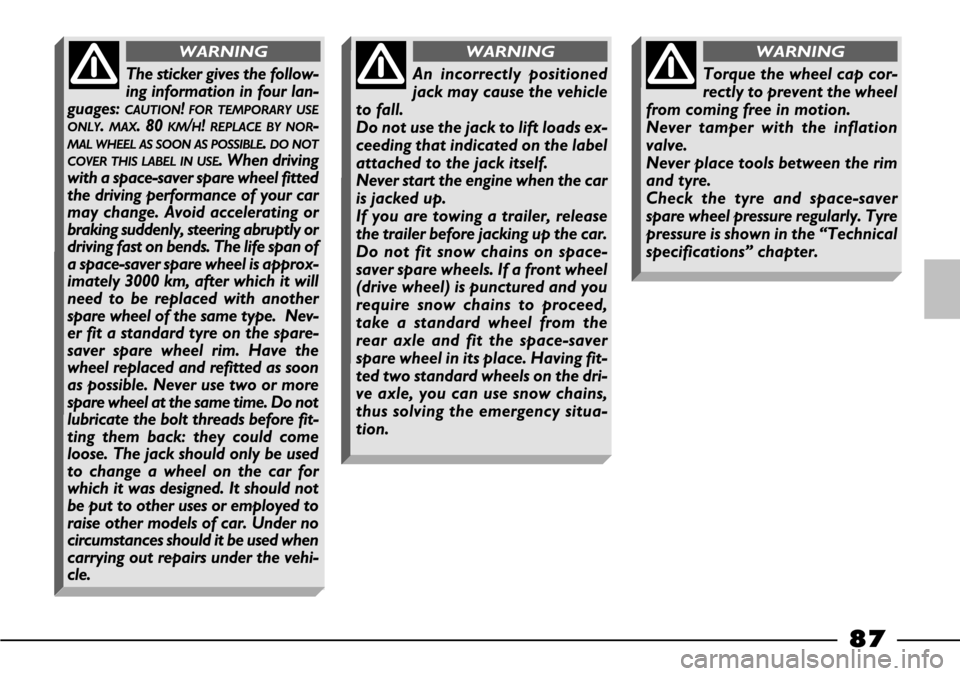
The sticker gives the follow-
ing information in four lan-
guages:
CAUTION!FOR TEMPORARY USE
ONLY
. MAX. 80 KM/H! REPLACE BY NOR-
MAL WHEEL AS SOON AS POSSIBLE. DO NOT
COVER THIS LABEL IN USE
. When driving
with a space-saver spare wheel fitted
the driving performance of your car
may change. Avoid accelerating or
braking suddenly, steering abruptly or
driving fast on bends. The life span of
a space-saver spare wheel is approx-
imately 3000 km, after which it will
need to be replaced with another
spare wheel of the same type. Nev-
er fit a standard tyre on the spare-
saver spare wheel rim. Have the
wheel replaced and refitted as soon
as possible. Never use two or more
spare wheel at the same time. Do not
lubricate the bolt threads before fit-
ting them back: they could come
loose. The jack should only be used
to change a wheel on the car for
which it was designed. It should not
be put to other uses or employed to
raise other models of car. Under no
circumstances should it be used when
carrying out repairs under the vehi-
cle.
87
WARNING
An incorrectly positioned
jack may cause the vehicle
to fall.
Do not use the jack to lift loads ex-
ceeding that indicated on the label
attached to the jack itself.
Never start the engine when the car
is jacked up.
If you are towing a trailer, release
the trailer before jacking up the car.
Do not fit snow chains on space-
saver spare wheels. If a front wheel
(drive wheel) is punctured and you
require snow chains to proceed,
take a standard wheel from the
rear axle and fit the space-saver
spare wheel in its place. Having fit-
ted two standard wheels on the dri-
ve axle, you can use snow chains,
thus solving the emergency situa-
tion.
WARNING
Torque the wheel cap cor-
rectly to prevent the wheel
from coming free in motion.
Never tamper with the inflation
valve.
Never place tools between the rim
and tyre.
Check the tyre and space-saver
spare wheel pressure regularly. Tyre
pressure is shown in the “Technical
specifications” chapter.
WARNING
Page 89 of 170
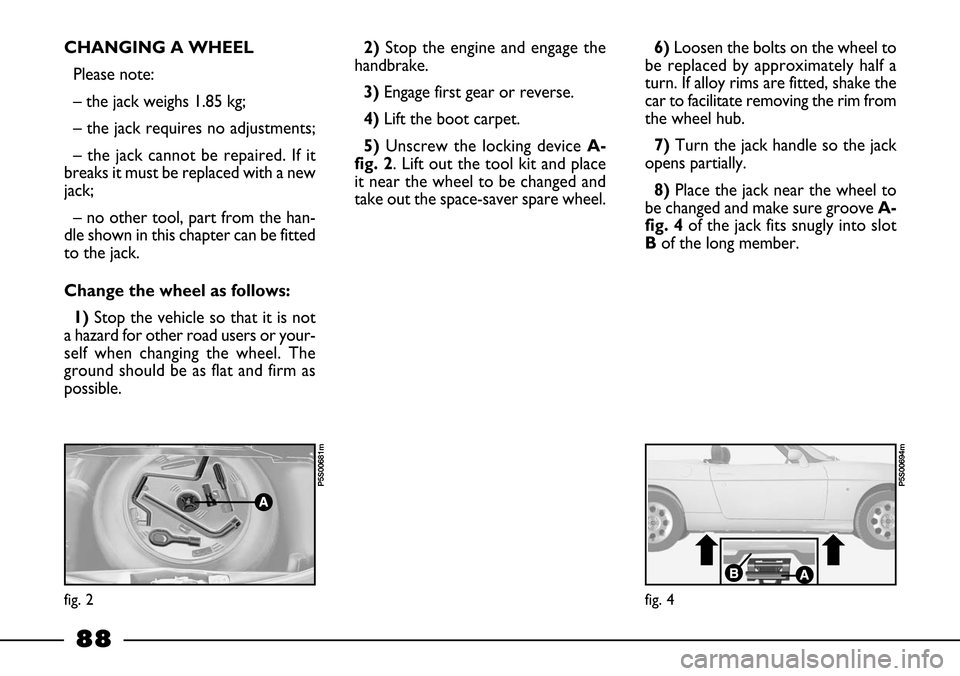
88
CHANGING A WHEEL
Please note:
– the jack weighs 1.85 kg;
– the jack requires no adjustments;
– the jack cannot be repaired. If it
breaks it must be replaced with a new
jack;
– no other tool, part from the han-
dle shown in this chapter can be fitted
to the jack.
Change the wheel as follows:
1)Stop the vehicle so that it is not
a hazard for other road users or your-
self when changing the wheel. The
ground should be as flat and firm as
possible.2)Stop the engine and engage the
handbrake.
3)Engage first gear or reverse.
4)Lift the boot carpet.
5)Unscrew the locking device A-
fig. 2. Lift out the tool kit and place
it near the wheel to be changed and
take out the space-saver spare wheel.6)Loosen the bolts on the wheel to
be replaced by approximately half a
turn. If alloy rims are fitted, shake the
car to facilitate removing the rim from
the wheel hub.
7)Turn the jack handle so the jack
opens partially.
8)Place the jack near the wheel to
be changed and make sure groove A-
fig. 4of the jack fits snugly into slot
Bof the long member.
fig. 2
P5S00681m
fig. 4
P5S00694m
Page 90 of 170

89
Depending on whether the normal
wheels are fitted with steel or light al-
loy rims, the spare wheel (always
made of steel) differs in order to be
compatible with the wheel bolts which
are specific for each of the two types
of rim.
If the type of wheel to be used is to
be changed (alloy rims in place of steel
rims and vice-versa) the bolts must al-
so be changed and a specific spare
wheel adopted.
Keep the bolts and the spare wheel
as they are essential if the original
wheels are to be refitted at some time
in the future. 9) Warn anyone nearby that the ve-
hicle is about to be lifted. They must
stay clear and not touch the vehicle
until it is back on the ground.
10) Turn the jack handle and raise
the car until the wheel is a few cen-
timetres above the ground.
The jack handle must turn freely,
without touching the ground to avoid
scraping your hands. Do not touch the
moving parts of the jack as they can
cause injuries. If you dirty your hands
with grease, clean them carefully.
11) Fully unscrew the 4 bolts, re-
move the wheel and, where provided
recover the wheel hub cap.
12)Make sure the surfaces of the
space-saver spare wheel that come in-
to contact with the hub are clean and
free from any impurities which could
result in the wheel bolts working
loose.13)Fit the spare wheel making sur
that pegs Bfit into holes A-fig. 5.
14) Tighten the four fastening bolts.
15) Lower the car by turning the jack
handle and remove the jack.
16)Tighten up the wheel bolts com-
pletely in criss-cross fashion follow-
ing the order shown in fig. 6.
17) Put the punctured tyre into the
space-saver spare wheel housing..
fig. 5
P5S10050m
fig. 6
P5S10049m
Page 91 of 170
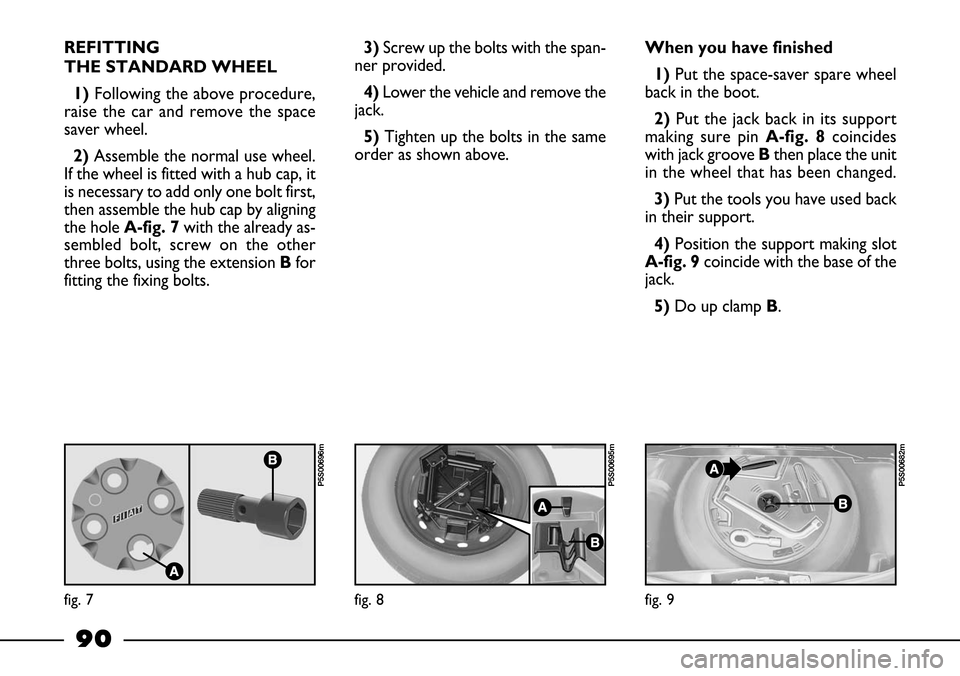
90
3)Screw up the bolts with the span-
ner provided.
4) Lower the vehicle and remove the
jack.
5)Tighten up the bolts in the same
order as shown above.When you have finished
1)Put the space-saver spare wheel
back in the boot.
2) Put the jack back in its support
making sure pin A-fig. 8coincides
with jack groove Bthen place the unit
in the wheel that has been changed.
3) Put the tools you have used back
in their support.
4)Position the support making slot
A-fig. 9coincide with the base of the
jack.
5)Do up clamp B. REFITTING
THE STANDARD WHEEL
1) Following the above procedure,
raise the car and remove the space
saver wheel.
2)Assemble the normal use wheel.
If the wheel is fitted with a hub cap, it
is necessary to add only one bolt first,
then assemble the hub cap by aligning
the hole A-fig. 7with the already as-
sembled bolt, screw on the other
three bolts, using the extension Bfor
fitting the fixing bolts.
fig. 7
P5S00696m
fig. 8
P5S00695m
fig. 9
P5S00682m
Page 116 of 170
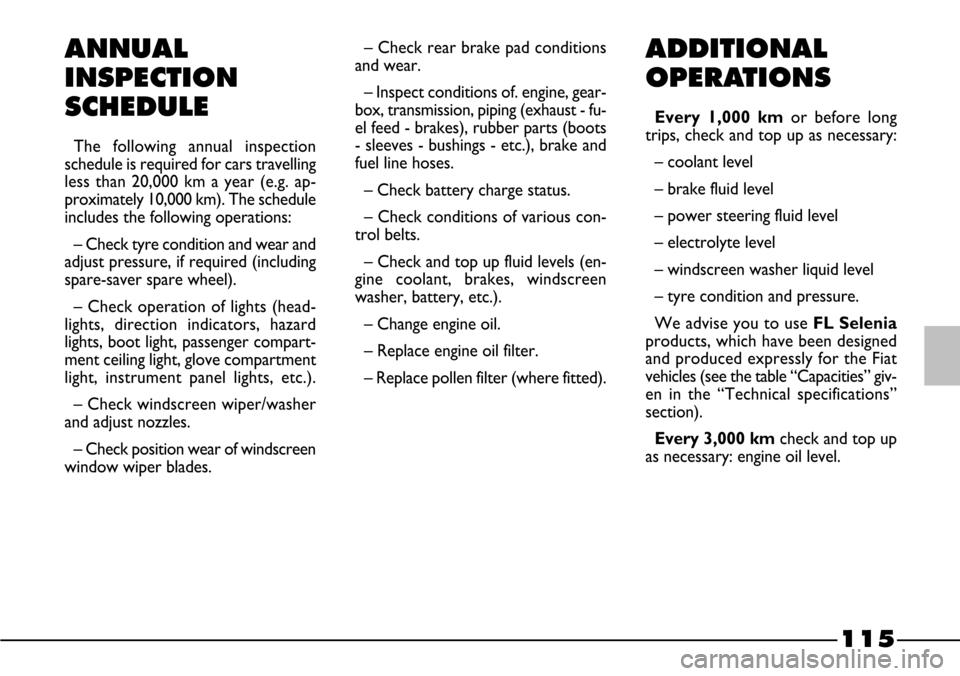
115
ANNUAL
INSPECTION
SCHEDULE
The following annual inspection
schedule is required for cars travelling
less than 20,000 km a year (e.g. ap-
proximately 10,000 km). The schedule
includes the following operations:
– Check tyre condition and wear and
adjust pressure, if required (including
spare-saver spare wheel).
– Check operation of lights (head-
lights, direction indicators, hazard
lights, boot light, passenger compart-
ment ceiling light, glove compartment
light, instrument panel lights, etc.).
– Check windscreen wiper/washer
and adjust nozzles.
– Check position wear of windscreen
window wiper blades.
ADDITIONAL
OPERATIONS
Every 1,000 kmor before long
trips, check and top up as necessary:
– coolant level
– brake fluid level
– power steering fluid level
– electrolyte level
– windscreen washer liquid level
– tyre condition and pressure.
We advise you to use FL Selenia
products, which have been designed
and produced expressly for the Fiat
vehicles (see the table “Capacities” giv-
en in the “Technical specifications”
section).
Every 3,000 km check and top up
as necessary: engine oil level. – Check rear brake pad conditions
and wear.
– Inspect conditions of. engine, gear-
box, transmission, piping (exhaust - fu-
el feed - brakes), rubber parts (boots
- sleeves - bushings - etc.), brake and
fuel line hoses.
– Check battery charge status.
– Check conditions of various con-
trol belts.
– Check and top up fluid levels (en-
gine coolant, brakes, windscreen
washer, battery, etc.).
– Change engine oil.
– Replace engine oil filter.
– Replace pollen filter (where fitted).
Page 127 of 170
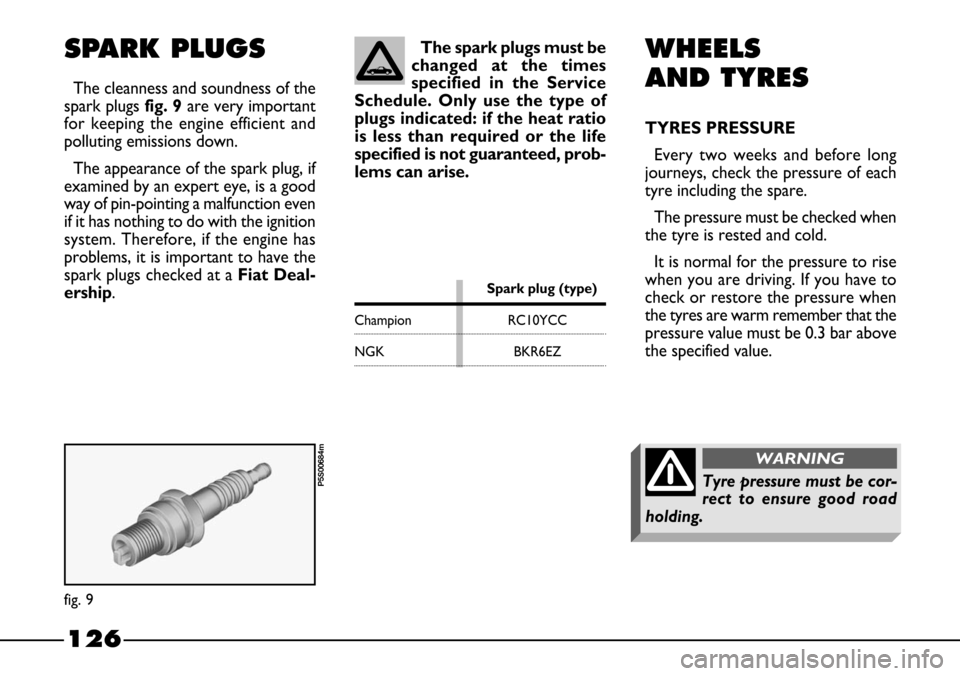
126
WHEELS
AND TYRES
TYRES PRESSURE
Every two weeks and before long
journeys, check the pressure of each
tyre including the spare.
The pressure must be checked when
the tyre is rested and cold.
It is normal for the pressure to rise
when you are driving. If you have to
check or restore the pressure when
the tyres are warm remember that the
pressure value must be 0.3 bar above
the specified value.
SPARK PLUGS
The cleanness and soundness of the
spark plugs fig. 9are very important
for keeping the engine efficient and
polluting emissions down.
The appearance of the spark plug, if
examined by an expert eye, is a good
way of pin-pointing a malfunction even
if it has nothing to do with the ignition
system. Therefore, if the engine has
problems, it is important to have the
spark plugs checked at a Fiat Deal-
ership.The spark plugs must be
changed at the times
specified in the Service
Schedule. Only use the type of
plugs indicated: if the heat ratio
is less than required or the life
specified is not guaranteed, prob-
lems can arise.
fig. 9
P5S00684m
Spark plug (type)
Champion RC10YCC
NGK BKR6EZ
Tyre pressure must be cor-
rect to ensure good road
holding.
WARNING